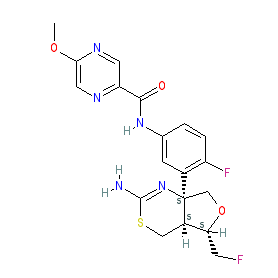GtoPdb is requesting financial support from commercial users. Please see our sustainability page for more information.
|
Compound class:
Synthetic organic
Comment: Using a set of PET ligand design parameters, compound 3 (PF-06684511) was rapidly identified as a lead with favorable in vitro attributes and structural handles for PET radiolabeling. Further evaluation in a LC-MS/MS cold tracer study in rodents revealed high specific binding to BACE1 in brain. Upon radiolabeling, [18F]3 demonstrated favorable brain uptake and high in vivo specificity in nonhuman primates (NHP), suggesting its potential for imaging BACE1 in humans [1].
Ligand Activity Visualisation ChartsThese are box plot that provide a unique visualisation, summarising all the activity data for a ligand taken from ChEMBL and GtoPdb across multiple targets and species. Click on a plot to see the median, interquartile range, low and high data points. A value of zero indicates that no data are available. A separate chart is created for each target, and where possible the algorithm tries to merge ChEMBL and GtoPdb targets by matching them on name and UniProt accession, for each available species. However, please note that inconsistency in naming of targets may lead to data for the same target being reported across multiple charts. ✖ |
|
|||||||||||||||||||||||||||||||||||
| References |
|
1. Zhang L, Chen L, Dutra JK, Beck EM, Nag S, Takano A, Amini N, Arakawa R, Brodney MA, Buzon LM et al.. (2018)
Identification of a Novel Positron Emission Tomography (PET) Ligand for Imaging β-Site Amyloid Precursor Protein Cleaving Enzyme 1 (BACE-1) in Brain. J Med Chem, 61 (8): 3296-3308. [PMID:29356535] |






